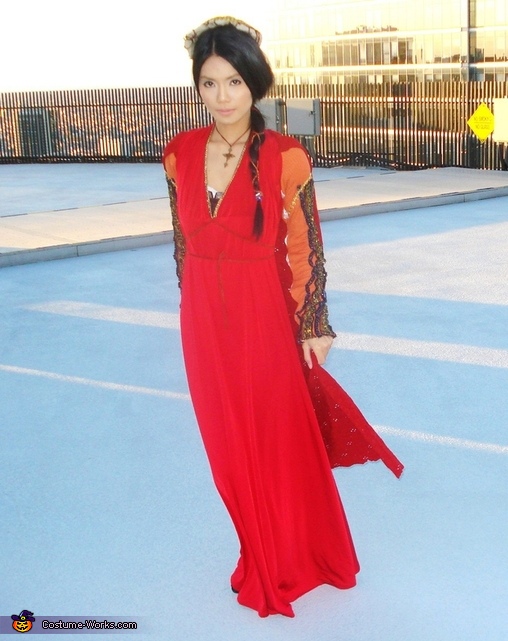When one delves into the realm of Shakespeare’s “Romeo and Juliet,” it becomes immediately evident that Juliet Capulet is more than just a character; she is a cultural symbol of love, tragedy, and youthful exuberance. From the elegant gowns of the Elizabethan era to modern interpretations, her costume has evolved remarkably. This article embarks on a journey through the myriad design choices reflecting the expectations and essence of Juliet, examining her costumes as a narrative device that deepens our understanding of her character.
The first aspect to consider is the socio-historical context of Juliet’s initial portrayal. In Shakespeare’s time, clothing served as a distinct indicator of societal status. Thus, Juliet’s costumes were meticulously designed to not only reflect her wealth as a Capulet but also to serve as a visual representation of her innocence and purity. Traditional interpretations depict Juliet in sumptuous fabrics—silks, velvets, and brocades, often in soft pastels that convey her youthful charm. Such choices are profound; they signify her initial naivete and the sheltered existence from which she ultimately yearns to escape.
As one starts to analyze costume designs in various productions, the palette of colors becomes a pivotal factor. In many adaptations, designers opt for warm hues such as creams, pinks, and light blues. These colors present Juliet as a symbol of romantic idealism. Additionally, the incorporation of flowing fabrics allows for a delicate visual representation of her fluid emotions. As she metamorphoses from an obedient daughter to a passionate lover, her attire often mirrors this transformation, with increasing layers and more intricate designs as her character embarks on a daring journey of love and rebellion.
Conversely, modern interpretations often take significant liberties, experimenting with styles that blend historical accuracy with contemporary elements. In many instances, costume designers employ avant-garde techniques and unconventional fabrics—think structured silhouettes and metallic finishes—creating a dichotomy that juxtaposes Juliet’s traditional innocence with a modern sense of independence and rebellion. Such designs aim to resonate with contemporary audiences, suggesting that Juliet is not merely a relic of the past but a timeless figure. When donned in a bold, daring outfit, she epitomizes the struggle between individual desires and familial obligations.
Costume designs also delve deeper into the emotional and psychological landscape of Juliet’s character. For instance, certain productions opt for costumes that render Juliet’s journey as one of duality. By employing contrasting elements—like a lavish gown paired with utilitarian footwear—designers can encapsulate her internal conflict between the restrictions imposed by her family and her aspirations for personal freedom. Fabrics that alternate between fluid and rigid can reflect her fluctuating emotions, enhancing audience empathy for her plight.
Moreover, accessories play an essential role in costume design as they often carry narrative weight. Jewelry, for instance, can symbolize both fidelity and entrapment. In traditional portrayals, pearls often represent purity, whereas ornate jewels might serve as a metaphor for the societal shackles imposed upon her. Even her hairstyle—a pivotal element of costuming—can be laden with meaning. A loosely braided updo might suggest romanticism, while a more constrained style might imply repression, thereby amplifying an audience’s understanding of her evolution.
As designs transition into the realm of creative drawings and visual interpretations, the stylization and artistic artistic expression offer new dimensions to Juliet’s character. Illustrators have the advantage of combining elements from various epochs and cultures, thus showcasing the universality of her story. Creative renditions may incorporate elements that reflect cultural aesthetics—Eastern motifs, tribal patterns, or even futuristic designs, thereby reinventing Juliet as a figure of both past and future. This allows the character to transcend temporal boundaries, engaging wider audiences in a dialogue about love, crisis, and identity.
Digital media has further revolutionized how costume design for Juliet is perceived and crafted. With the advent of 3D modeling and augmented reality, the possibilities are endless. Designers can visualize intricate details, from the draping of a gown to the shimmer of a necklace, before a single stitch is made. This cutting-edge approach not only enhances the costume’s accuracy but also offers designers the ability to engage with audiences in immersive experiences. By allowing viewers to explore costume elements interactively, they can gain a deeper appreciation for the artistry and intention behind each detail.
Ultimately, the journey through the various interpretations of Juliet Capulet’s costume is emblematic of the broader cultural discourse surrounding the themes of love, freedom, and identity. It brings forth the notion that costumes are not merely garments; they are a visual language, a method of storytelling that enriches the narrative. Each design choice—color, fabric, silhouette, and accessory—contribute to a composite portrayal of Juliet that resonates with audiences across generations.
From the opulent dresses of Elizabethan theaters to modern avant-garde interpretations, Juliet’s costume not only reflects her personal journey but also the societal constructs surrounding her. As she navigates her quest for love against the backdrop of familial expectations, her attire serves as both armor and expression. In doing so, it becomes clear that Juliet’s legacy transcends time, remaining a vital part of the theatrical experience. As we continuously recreate her image, we reaffirm her position within the canon of literature, ensuring that her story persists in the collective consciousness.

